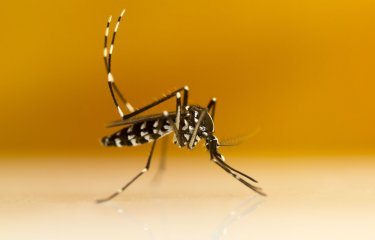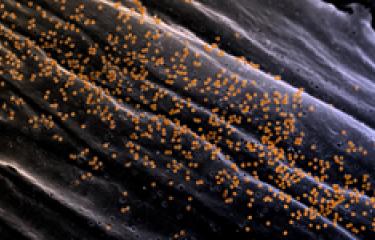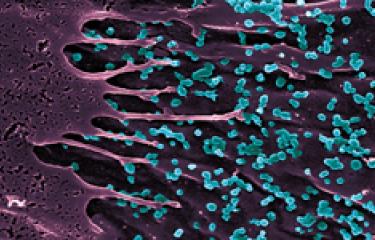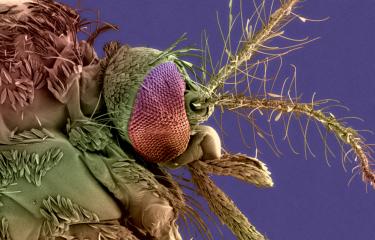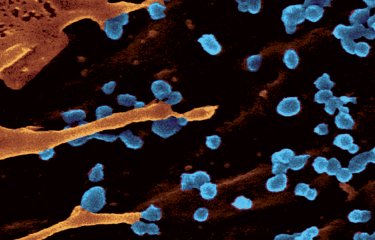Researchers at the Institut Pasteur have managed to retrace the origin and evolution of the Chikungunya virus in the Indian Ocean through complete sequencing of the genome of six viral strains isolated from patients from Reunion Island and the Seychelles, as well as through partial sequencing of the viral protein E1 from 127 patients from the Indian Ocean islands (Reunion,Madagascar, Seychelles, Mauritius, Mayotte). Their study, published in PLoS Medicine, opens up new research paths that should help to explain the magnitude of the epidemic and the occurrence of severe forms of the disease.
Press release
Paris, may 23, 2006
For the first time ever, the complete genome sequences of the Chikungunya virus have been identified from viral isolates obtained from a low number of cell culture passages and therefore very close to the clinical virus, whereas to date the complete genomes identified were those of laboratory strains. This study, started at the National Reference Centre for Arboviruses, was continued on a large scale by the Institut Pasteur’s technological platform Genotyping of Pathogens and Public Health . This work was undertaken in order to gain a better understanding of the origin and evolution of the viruses responsible for an epidemic of unprecedented magnitude. This outbreak started in early 2005 in Comoros, and has caused 248,000 cases in the Reunion Island between March 2005 and April 28, 2006 and 5834 cases in Mayotte, 8976 cases in the Seychelles, 6000 cases in Mauritius.
The study was supervised by Sylvain Brisse, head of the Pathogen Genotyping and Public Health Platform at Pasteur Genopole Ile-de-France, and Isabelle Schuffenecker of the Arbovirus National Reference Centre in Lyon, in collaboration with several teams from the Institut Pasteur in Paris, and with clinicians and virologists from the Reunion island, Madagascar (Institut Pasteur), Mayotte et the Seychelles.
The study shows that the Indian Ocean viral strains are closely related to each other and are related to East, Central and South African strains isolated between 1952 and 2000. The viruses that emerged in the Indian Ocean were therefore probably imported from the African continent. This scenario is compatible with the human population exchanges between East Africa and the Comoros where the epidemic started in early 2005. Moreover, changes that occurred in the viral genome as the epidemic progressed, especially the emergence and predominance of a particular genotype since September 2005, suggest an adaptive evolution of the viral strains.
Sequencing of the complete genome of a viral strain isolated from the cerebrospinal fluid (CSF) of a Reunion Island patient suffering from meningo-encephalitis revealed several mutations causing amino acid substitutions specific to this clinical isolate. Studies are currently underway to establish whether these substitutions are linked to the neurovirulence of the Chikungunya virus, on the one hand, and to greater efficiency of viral multiplication, on the other hand.
The viruses’ " molecular signatures ", which constitute genetic fingerprints, in virus envelope protein E1 have also been found. As the three dimensional structure of E1 in a very similar alphavirus, the Semliki Forest virus, had already been ascertained by Felix Rey’s team, this made it possible to provide a model of the structure of E1 of the Chikungunya virus in order to locate the mutations. One of these signatures(" E1 226 " : see figure below), not found early on in the epidemic, became predominant in Reunion Island strains from September 2005, and therefore shortly before the epidemic explosion. The authors suggest that this signature may confer an advantage and favour the multiplication of the virus in Aedes albopictus, its vector (protein E1 is in fact involved in attaching the virus to the mosquito’s cell membranes).
The magnitude of the epidemic in the Indian Ocean and the description of new clinical froms of the disease has underlined "the critical lack of understanding of the physiology of the disease and the biology of the virus", as the authors point out.
The molecular data presented here is a first step to bridge this gap of knowledge and opens the way to functional studies. A dozen teams at the Institut Pasteur have indeed been working for several weeks on unveiling the mysteries of Chikungunya virus. Their research should, at middle-term, contribute to the development of tools to help combat this neglected disease.
Sources
"Genome microevolution of Chikungunya viruses causing the Indian Ocean outbreak" : PloS Medicine, 23 mai 2006.
Isabelle Schuffenecker (1), Isabelle Iteman (2), Alain Michault (3), Séverine Murri (1), Lionel Frangeul (4), Marie-Christine Vaney (5,9), Rachel Lavenir (2), Nathalie Pardigon (6), Jean-Marc Reynes (7), François Pettineli (12), Leon Biscornet (13), Laure Diancourt (2), Stéphanie Michel (1), Stéphane Duquerroy (5,9,10), Ghislaine Guigon (2), Marie-Pascale Frenkiel (6), Anne-Claire Bréhin (6), Nadège Cubito (1), Philippe Desprès (6), Frank Kunst (8), Félix A. Rey (5,11), Hervé Zeller (1) et Sylvain Brisse (2)
1 Centre National de Référence des Arbovirus, Institut Pasteur, Lyon;
2 Plate-forme Génotypage des Pathogènes et Santé Publique, Institut Pasteur, Paris ;
3 Laboratoire de Microbiologie, Hôpital St Pierre, Ile de La Réunion ;
4 Plate-forme Intégration et Analyse Génomique, Institut Pasteur, Paris ;
5 Unité de Virologie Structurale, Institut Pasteur, Paris ;
6 Unité des Interactions Flavivirus-Hôtes, Institut Pasteur, Paris ;
7 Unité de Virologie, Institut Pasteur, Madagascar ;
8 Unité de Génomique des Microorganismes Pathogènes, Institut Pasteur, Paris ;
9 CNRS/INRA UMR 2472/1157 ;
10 Université Paris XI-Orsay ;
11 CNRS URA 1930 ;
12 Laboratoire de Biologie Médicale, Centre Hospitalier de Mayotte, France ;
13 Disease Surveillance and Sexually Transmitted Infections Units, Seychelles Public Health Laboratory, Ministry of Health and Social Services, Victoria, Mahe, Seychelles.
Contact press
Institut Pasteur Press office
Nadine Peyrolo ou Corinne Jamma
+33 (0)1 40 61 33 41 - cjamma@pasteur.fr




